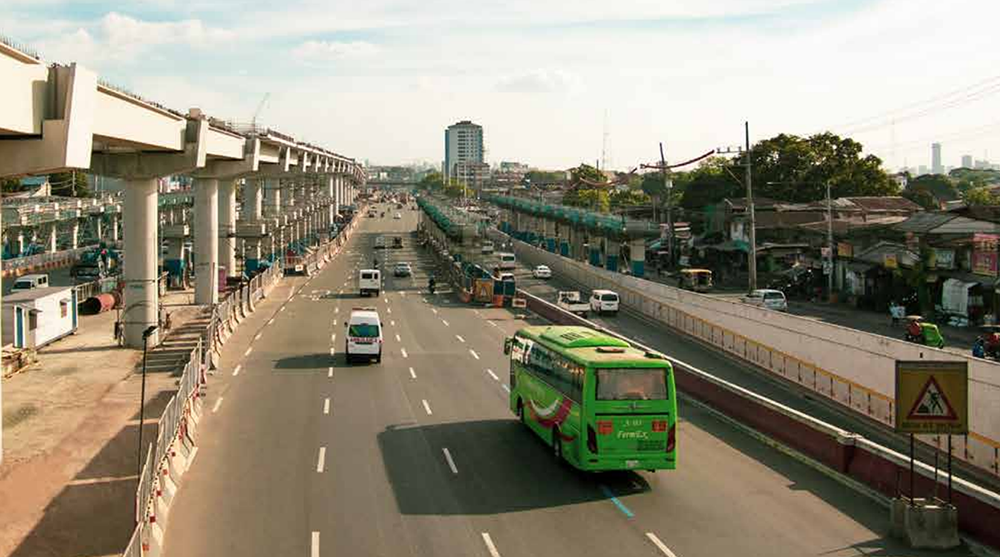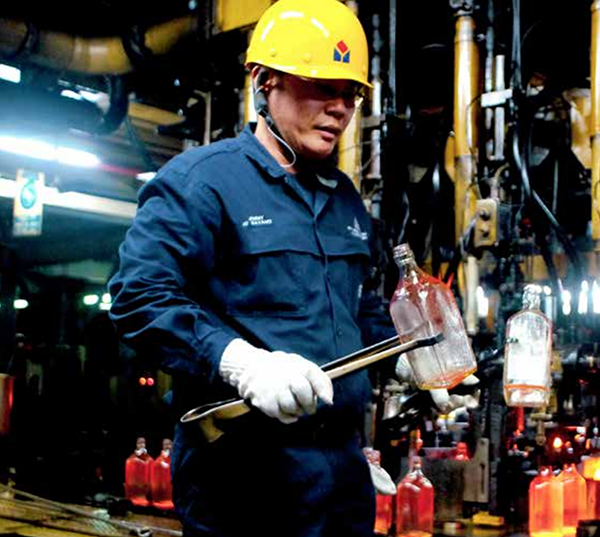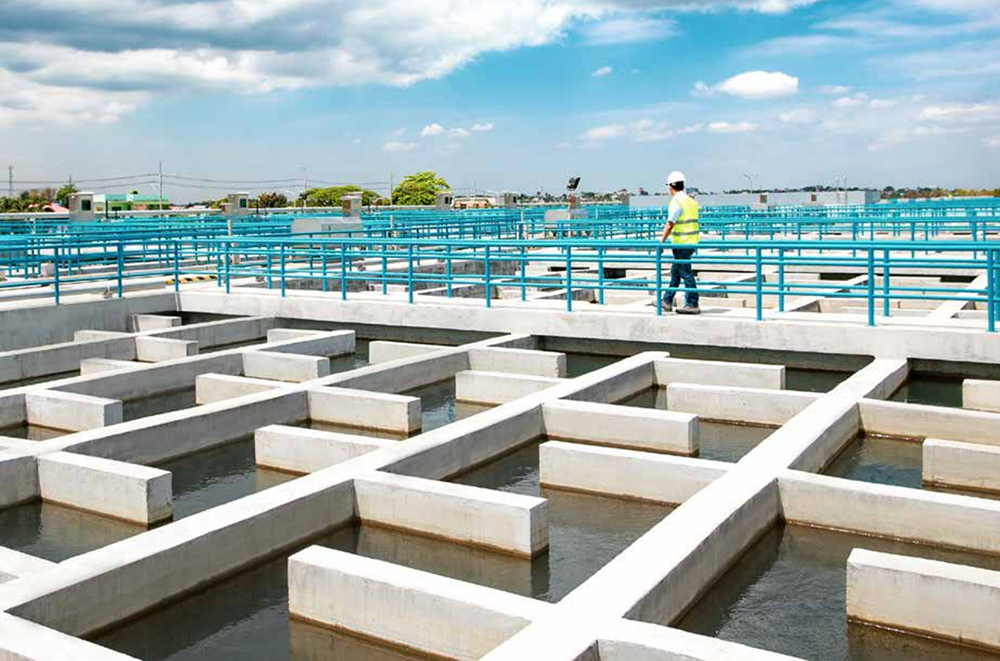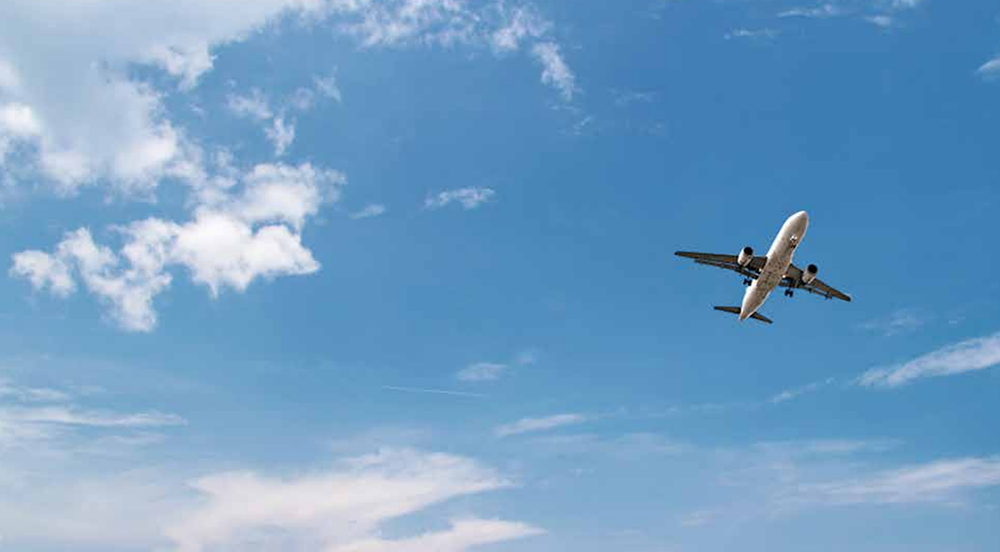San Miguel’s positive impact should always exceed its size
Companies generally take baby steps when it comes to something as complex as sustainability. In the case of San Miguel however, it was giant strides from the outset.
As one of the Philippines’ largest corporates, we recognize we have a responsibility to make a positive difference in making sure future generations have the same, if not better, opportunities than we do today. In this regard, we made two major decisions to reduce our environmental impact in 2017.
The first was to cut by 50% utility and domestic water use across the entire San Miguel group by 2025. In the two years since, we’ve managed to save some 8.8 billion liters of water, representing a 25.3% reduction in our overall use. We’re well ahead of our goal to reduce consumption by 20% in 2020, and are confident we will be able to reach our target.
Our second decision was to discontinue our plastic bottled water business, effectively removing some 32 million plastic bottles a year, which would have ended up in landfills or bodies of water, had we continued the business.
For us then, the key to sustainability and addressing climate change is looking after our water resources and reducing our carbon footprint. Both are relevant to our business operations and have the potential to drive competitive advantage and innovation for our company.
Beyond this, addressing societal challenges is a natural extension of what we do, and we’re working at better aligning the way we do business with larger societal needs. In terms of our supply chains, we are partnering with farmers and backyard livestock operators to transfer technology and help raise rural incomes. Our work in this area continues to evolve, and our Food Group has deployed supplier engagement teams to provide training and further develop skills around building sustainable and resilient supply chains.
Like many other companies, our previous efforts in corporate social responsibility have included promoting employee volunteerism, providing donations in kind, and providing grants to, or partnering with charitable organizations. We’re moving away from that model. Today, our social development and corporate giving arm, San Miguel Foundation, functions as an ideas incubator for the kind of social innovation we can adopt to tackle problems like income disparity, hunger, and poverty.
We invest in our communities not only because it makes good business sense, but also because we believe that the private sector needs to do its part in solving the most pressing economic, social, and environmental challenges of our times.
Our Better World Communities will be vehicles for community engagement, providing the social scaffolding to enhance the civic life of ordinary Filipinos.
Our partnership with learning organizations like the School of Experiential and Entrepreneurship Development (SEED) and AHA! Learning Center, is based on the belief that everyone should have a fair shot at opportunity, and that San Miguel can contribute to a growing economy that can work for everyone, especially those who need help the most.
In San Miguel’s new vision-mission statement of 2017, sustainability emerged as an entirely new value among seven identified core values.
To make sure that this commitment to sustainability is embedded at every level of our company, San Miguel has a clear set of social, economic, and environmental goals across our operating businesses. We look forward to reporting to you on our progress.
Just two years into our goal of cutting group-wide water use by 50% by 2025, ripples of change are becoming waves of success.
“Water is a basic human resource and a basic right. But it's also an essential ingredient to our products and businesses. Our responsibility therefore is far greater than most,” says SMC president and COO Ramon S. Ang.
In 2017, we announced our commitment to halve our non-scarce, non-product water use by 2025. Even as our water management efficiency levels are already among the highest in the Philippines, and while water conservation has always been a key component of our operations, we've challenged ourselves to do more.
Two years in and we’ve made significant headway in what is perhaps the most ambitious sustainability goal ever set by a Philippine company.
We had trained our sights on a mid-term goal of 20% reduction by 2020, and we’re proud to report that we have surpassed this milestone a full two years ahead of schedule.
In 2018, the company posted an aggregate of 25.3% reduction in water consumption, a staggering 8,841,000 cubic meters (m3) equivalent to the consumption of roughly 295,000 households. This was achieved through an integrated water management strategy that combines conservation with process water reuse, recycling, and technology.
Over 14% or about 5.1 million m3 is represented by the use of non-scarce resources such as sea water, rainwater, and other recycled water. Petron remains the biggest user of nonscarce water. Today, more than 29% of water used in Petron's operations derive from alternate sources. This includes desalinated sea water at its Bataan Refinery, and rainwater harvested in most of its terminals.
Efforts by San Miguel Brewery Inc. to reuse treated wastewater effluent for gardening and utilities and its closer monitoring and fixing of leaks in all facilities have further improved SMB's water efficiency levels.
And while many facilities have made good progress in reducing their water use, Petron made the biggest contribution with a 37.55% cut in use; SMC Global Power Holdings Corp, reported a 37.31% reduction; and Northern Cement, cited 32.28% less usage over 2016 baseline figures.
In terms of volume of water saved, Petron leads the way with 6.6 million m3 saved. SMC Global Power saved 1,008,000 m3, while SMB saved 496,000 m3.
”Water for All” was a pivotal moment for San Miguel's sustainability aspirations. It provided us the inspiration to take on other environmental issues, such as waste management.
Bulacan is set to be the next major economic growth center outside Metro Manila. San Jose del Monte is where it all begins.
On a good day in the early 1990s you could get to San Jose del Monte, Bulacan from Quezon Circle in thirty minutes, tops. Assuming you knew it even existed.
Back then, for most Metro Manila dwellers, civilization ended at Fairview subdivision.
In truth, just a few minutes away, via the then two-lane, often-potholed Quirino Highway, San Jose del Monte or SJDM was already slowly beginning its ascent. Families were resettled here from other urban areas. Low-cost housing also attracted many others. By the early 2000s, San Jose del Monte’s population was steadily increasing, making it a sizeable market: an emerging local economy.
Today, no one will say that San Jose del Monte is at the end of nowhere. It is a bustling metropolis poised to become a major growth center north of Metro Manila. Its prospects can only be made better by the MRT-7 project.
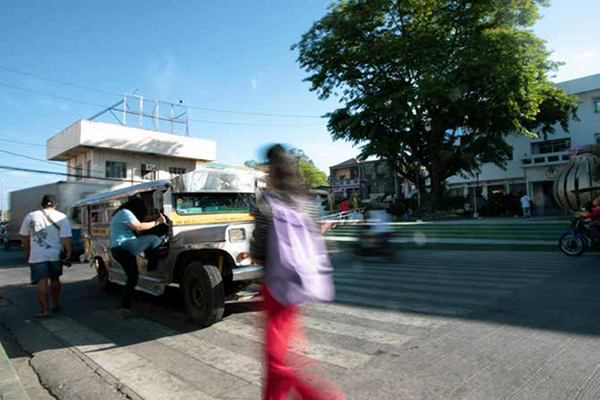
With the construction of major infrastructure projects, San Jose del Monte is poised for growth.
Directly connecting to the LRT-1 and MRT-3 in Metro Manila, the 22-kilometer MRT-7 will have 108 modern rail cars that can ferry up to 850,000 passengers per day through 14 major stations.
With it, residents of SJDM and other parts of Bulacan no longer need to spend hours in traffic every day commuting to Metro Manila for work. Many of them may not even need to leave home. With Bulacan real estate values still relatively affordable, it's the business owners, investors, and locators looking for growth areas for their businesses, who will come to town and bring with them job opportunities.
Residential developments—including those from the country’s largest property developers—have also gone up. Commercial developments, including malls and food chains, have also set up shop.
With fast, direct access by rail—something even high-growth cities and provinces south of Metro Manila are still without—SJDM is looking more and more like a better alternative for those looking for a place to work and live.
And yet, rail is just one part of the equation. On the San Jose del Monte station of MRT-7 will also rise an inter-modal transportation terminal. This will connect directly to the North Luzon Expressway via the 22-km. road component of the MRT-7.
SJDM also plays host to another major infrastructure asset, SMC’s Bulacan Bulk Water Supply Project (BBWSP). For the longest time, the entire Bulacan province has grappled with the lack of a reliable source of water—ironic, given that Metro Manila’s major water source, Angat Dam, is located in the province.
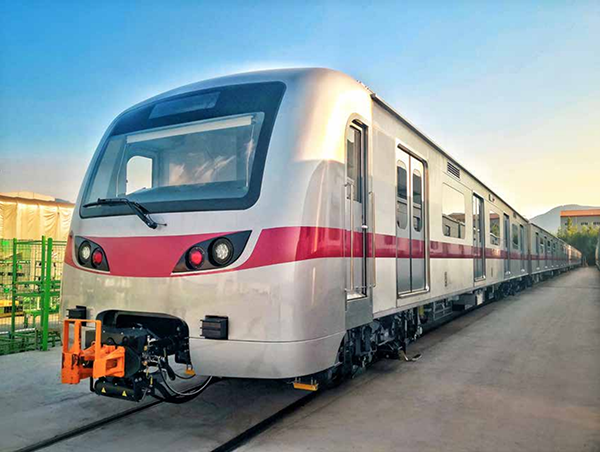
One of the actual trains to be used for MRT-7, to be shipped from Korea.
Bulakeños have long relied on extracting water from the ground. Because of this, many deep wells have run dry and subsidence is a real threat.
BBWSP which was made operational in January, will deliver treated, potable water from Angat to Bulacan’s 24 water districts at P8.50 per cubic meter—the lowest bulk water rate in the country.
SJDM may be where many major infrastructure projects converge, but Bulacan province as a whole stands to benefit from San Miguel's projects.
The economy of Bulacan is about to get an even bigger boost with our most ambitious infrastructure investment: the US$14‑billion New Manila International Airport, the country’s next and biggest international aviation hub, to be built in the province.
This massive airport development will include a seaport and industrial and residential zones that will make Bulacan a gateway to the Philippines and a jump-off point to the world. It's a game‑changer that will help drive our country’s economic future.
Recognizing that true empowerment lies not in giving handouts, the San Miguel Better World Community aims to help people help themselves.

The Better World Community in Tondo, Manila aims to help lift more families out of poverty.
Transformation often begins on a local scale and with a single project. In trying to make a difference, San Miguel understands that positive change begins with the most basic of units—the family. We also know that before change can take hold, we first have to address their most basic need— food.
Alongside its multimillion infrastructure projects, San Miguel is also investing in communities, creating centers that will feed and teach and hopefully, remove the barriers that keep people from thriving.
San Miguel’s first Better World Community is at the epicenter of a landscape marred by hunger and grinding poverty.
In Tondo, Manila, some 3,000 families—roughly 15,000 people—live in Aromaland, a housing relocation site. Beside it is Happyland,where over 12,000 people live. The residents of Happyland and Aromaland are among the growing ranks of the “ultra poor”—those who live on less than P25 a day.
None of them have anything remotely resembling adequate shelter, clean water and sanitation, electricity, education, or healthcare.
San Miguel’s Better World Community hopes to redress and address some of these inequalities. Located in Barangay 101, barely 500 meters away from Aromaland, what was once an idle, 1,000-squre meter former beer warehouse and distribution center will become a staging ground for San Miguel’s social agenda: creating an environment that will allow the poor to grow their own impact.
But even a trillion-peso company like San Miguel can’t always know how best to help people at the bottommost rung of the ladder. The hope is that through the Better World Community, San Miguel will better learn how to create a more supportive ecosystem that can lift more families out of poverty
But even a trillion-peso company like San Miguel can't always know how best to help people at the bottommost rung of the ladder. The hope is that through the Better World Community, San Miguel can create a more supportive ecosystem that can lift more families out of poverty.
The first order of the day is to address the issue of hunger. In this regard, San Miguel, through San Miguel Foundation, has partnered with the Philippine chapter of Rise Against Hunger, an international hunger relief organization that distributes food to society’s most vulnerable.
The Better World community would prioritize children, the elderly, the disabled, and single mothers. To keep kids in school, neighboring public schools will also receive daily rations. San Miguel’s target is to provide at least three million meals annually, consisting of pre-packed nutritious meals and donations of unused, surplus food from restaurants, fastfood chains and convenience stores. Through this effort, issues of food waste and hunger are both addressed.
But stopping hunger in its tracks is just a start. What San Miguel and its prospective partners hope to do is to capacitate the people of Tondo through bottom-up participatory involvement. Those who will benefit from the community will be asked to serve it—by volunteering to cook, wash plates, or keep the grounds clean. For the mothers and fathers who will be asked to pitch in, it’s not a form of payment as much as it is an opportunity to have a direct hand in providing food for their own kids.
Further down the road, we hope to address other major determinants of poverty, such as lack of livelihood skills, illiteracy, little or no health care, and social exclusion.
Once operations are up and running, more partners will be asked to sign up. AHA! Learning, an after-school learning start-up is among the many NGOs being tapped to teach adults and children basic literacy and numeracy.
But the chief actors in solving the problem of poverty in Barangay 101, Happyland and Aromaland will be the poor themselves. As a company, we believe in people’s power to change their own lives. They have the understanding to create solutions for their own communities and to control their own futures; we only need to give them the capability and opportunity to do so.
In Purok Seppina, Barangay Dela Paz, Antipolo, there is a small, two-storey house with a sari-sari store and a tiny grotto of Our Lady of Lourdes. A plain white sign reads “Marawi Hero Store.”
This is the home of Leopoldo Lolo, father of Jan Michael Lolo, who at 26 years old died a hero during the Marawi siege.
According to Leopoldo, his son joined the Marines in 2016 at age 25. He enlisted for all the unsurprising reasons: his father was a soldier too, serving in the Philippine Army for 16 years; he wanted a stable income; his maternal grandfather was also an army man. To Jan Michael, joining the military was a calling.
Before enlisting, he worked for a time in construction, but felt he wasn’t making enough money to give to his parents.
In Marawi, while holed up in different abandoned homes, he would call his parents on Facetime and tell them what he’d been up to that day, and that he was fine.
On July, 29, 2017, he was hit by sniper fire during a brief firefight.
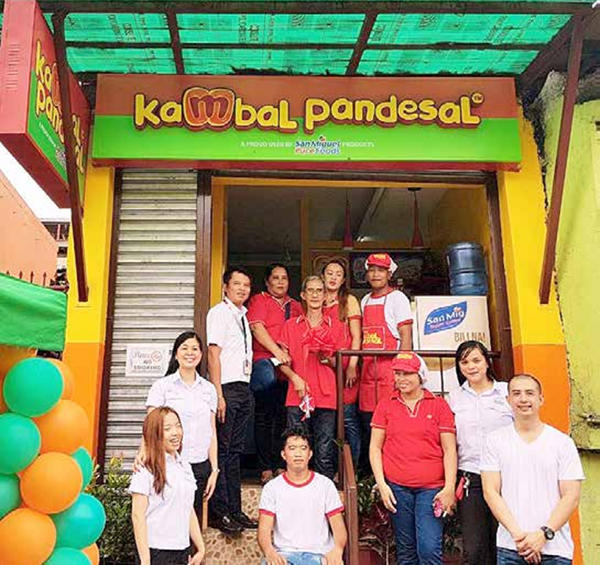
The Lolo family with representatives from San Miguel Mills at the opening of their Kambal Pandesal outlet last July 2018.
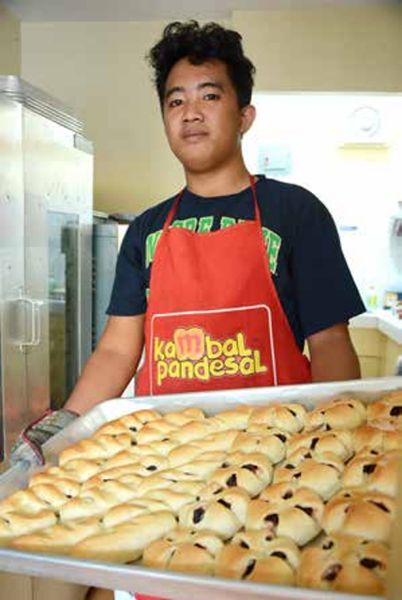
Joven Lolo, Jan Michael's brother helps run the bakery.
For his service, Jan Michael received a posthumous Kalasag Medal under the Order of Lapu-Lapu, awarded to government troops who were killed-in-action during the Battle of Marawi. His parents, Leopoldo and Alma, went to Malacañang to receive the honor. Along with a title to a house and lot, they were given a lump sum death pension that allowed them to open the sari-sari store and make improvements to their home.
The Lolos are just one of the 166 families with loved ones who were killed-in-action (KIA) in Marawi. In October 2017, after the conflict ended, San Miguel president and chief operating officer Ramon S. Ang visited Camp Aguinaldo to meet with the families of the fallen and to sign a memorandum of agreement creating a P330 million fund awarding each KIA family a business startup package.
Under this package, families can select any franchised business from SMC, including Kambal Pandesal, BMEG Feeds, TJ Hotdog, and San Miguel Food Avenue.
San Miguel president and chief operating officer Ramon S. Ang visited Camp Aguinaldo to meet with the families of the fallen and to sign a memorandum of agreement creating a P330 million fund awarding each KIA family a business startup package.
Kambal Pandesal, the franchised bakery business under San Miguel Mills (SMMI), is proving very popular among the families. Bob Labrador, SMMI retail business manager, says the business is often the right scale that families can manage.
“Every barangay has at least one bakery. Going to the corner bakery in the early morning or on your way home from work in the evening is something everyone can relate to.”
Some 66 KIA families have signed up for a Kambal Pandesal business and at present, 10 are already up and operational. The Lolo franchise was the third, and in the six months that the store has been up, it’s been turning a steady profit. At least eight of the first 10 KIA stores are doing better than the national average.
The Lolo family usually earns anywhere between P20,000 to P25,000 a month.
The Kambal Pandesal franchise package includes ten days training on the basics of managing the business, accounting, and baking. Families are also taught how to be customer and service-oriented.
SMMI staff help with all the paperwork and permits, and an operations officer is assigned to the families to help balance the books each month.
Of the total 166 KIA families, over 120 have already been matched with a business. The BMEG franchises are also popular among beneficiaries. Others have opened small food stalls selling TJ Hotdogs or Magnolia ice cream. None of the beneficiaries have run into any major problems.
The most successful beneficiary is Aileen Oraliza who runs a Kambal Pandesal franchise in Siargao, earning sales of around P14,400 a day.
For some though, it’s been a steep learning curve; not everyone is a natural entrepreneur. But with support from San Miguel, the hope is that each family will make the most of this gift honoring their loved ones.
Before sustainability was even a buzzword, our Packaging business was already championing a circular economy— minimizing waste through recycling.
A recent global survey on consumer habits found that a third of consumers vote with their wallets, choosing brands they believe are doing social or environmental good.
For many, a good part of that brand image involves the use of packaging. Sustainable packaging is probably one of the most influential purchasing drivers among millenial consumers. Having swapped plastic bottles for reusable glass and metal, and having ditched disposable straws, consumers are turning to more sustainable alternatives like biodegradable packaging formats, or visiting refilling stations with used containers rather than buying brand new packaged products.
Today, more people are holding manufacturers accountable for managing post-consumer waste. The packaging industry along with the FMCGs—whose plastic packaging often wash up on beaches and coastlines— are under pressure.
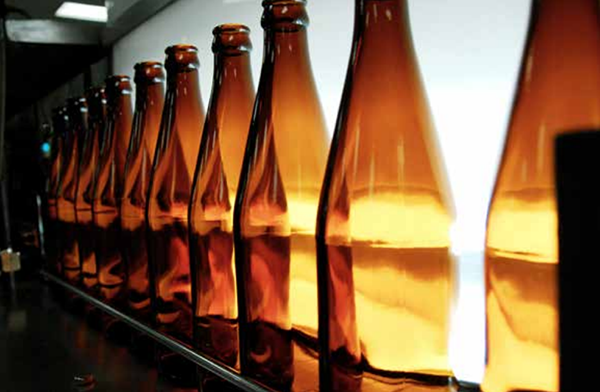
Glass is highly recyclable and can be reused endlessly. SMB's returnable bottle system is a prime example of a closed loop packaging sytem.
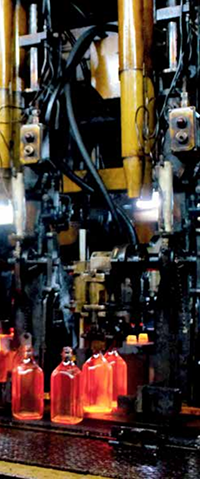
For the past 80 years, the Philippines’ largest packaging company, San Miguel Yamamura Packaging Group (SMYPG), has taken a sustainable, circular approach to business, long before the terms sustainability and circular economy became the buzzwords they are today.
For starters, SMYPG’s portfolio is predominantly glass, constituting over 44% of the company’s product mix. Plastics comprise 21% of the portfolio, corrugated cartons makes up 10% and cans make up 7%. All these products are recycled by the company. Flexibles and laminates, the material that goes into sachets and retort pouches, comprise less than 5% of the total portfolio.
“Glass can be reused and recycled endlessly without compromising on quality or functional safety. That’s why it's a key aspect of our business sustainability strategy,” says Ferdinand Tumpalan, President of San Miguel Yamamura Packaging Group.
“Our packaging business has always brought a solutions approach to our customers' needs. The customer has always been at the center of SMYPG’s thinking. Today, the environment is too,” says Ramon S. Ang, President and Chief Operating Officer of San Miguel Corporation, SMYPG’s parent.
Recovery and recycling play a huge part in the company's sustainability model. It works with local waste aggregators and garbage sorters to collect aluminum cans, plastic and metal caps, and other packaging wastes that can be repurposed and recycled into new products.
In a number of provinces where the local governments control landfills, SMYPG is an active partner in materials recovery. The company has set up cullet collection hubs to raise efficiencies in the recovery of used glass bottles.
San Miguel Yamamura Asia Corporation (SMYAC), the country’s largest glass plant, historically uses up to 65% recycled glass.

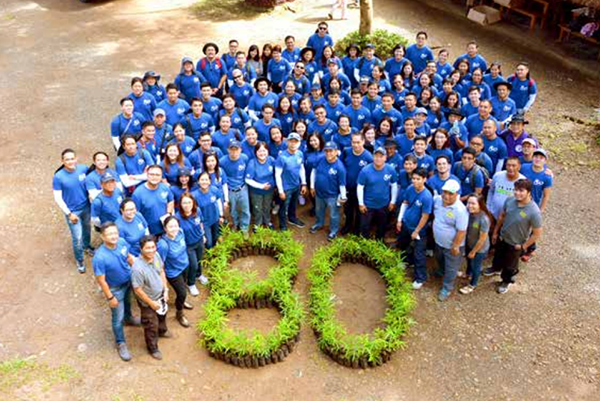
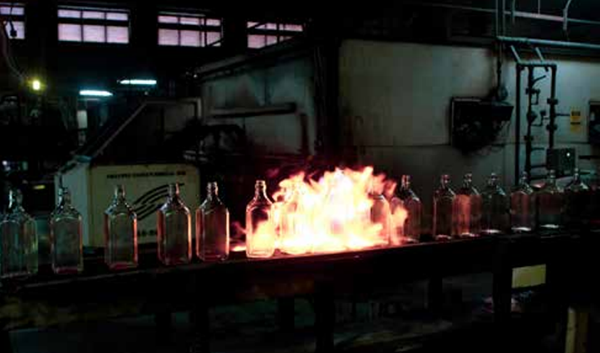
Likewise, SMYPC’s Cebu Glass Plant scores an even higher historical record of using up to 97% recycled glass in its manufacture of glass products.
Other packaging formats are also recycled. Pallets and crates that have outlived their usefulness are retrieved from customers, crushed and cut into tiny pieces, and returned to SMYPG’s plastics plant where they are recycled into new pallets and crates.
Tumpalan says, “We have a great record of recycling our plastic products. At the end of its lifespan, each crate or pallet we produce becomes part of a new crate or pallet. We manufacture plastics that can last five or ten years, but durability is just one of the product attributes we strive for. Recyclability is another.”
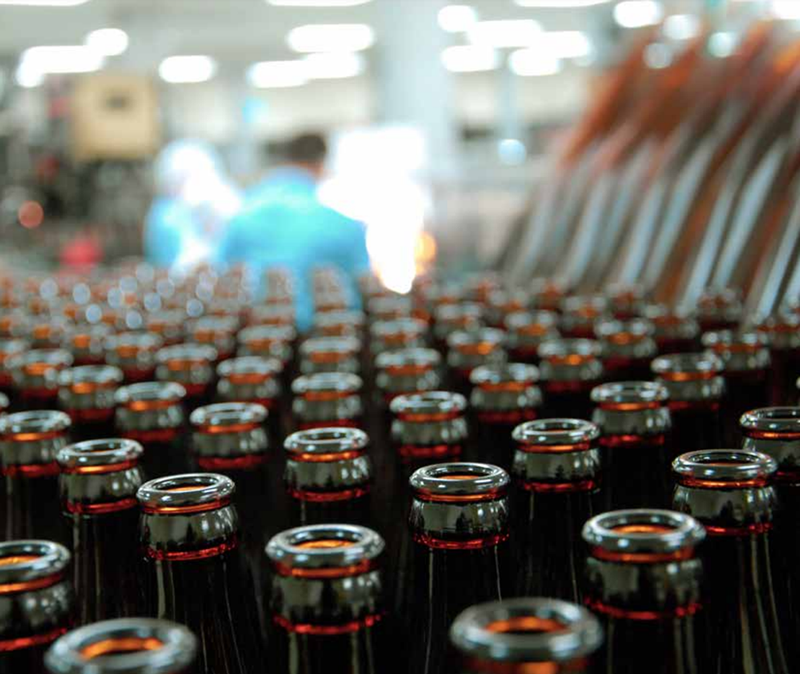
Can Asia, Inc. (CAI), SMYPG’s aluminum can facility, recycles aluminum scraps and trimmings.
This scrap is sold to the company’s aluminum coil suppliers and converted back to coils with a minimum 90% recycled aluminum content. Producing aluminum uses a lot of energy. By using recycled aluminum, SMYPG contributes to minimizing the energy required in primary aluminum production and reduces volume of emissions by 90%. Adds Tumpalan: “We want to be resource efficient and at the same time, we try to close the loop.”
Even in its flexibles business, SMYPG manages its waste as efficiently as possible. Plastic trimmings are shredded and used as fuel feedstock in Northern Cement, a former subsidiary. “A majority of plastics have an end-of-life use and we want to turn waste into something that can be useful beyond its primary purpose,” Tumpalan says.
“SMYPG will be leading the way in innovative solutions to cut back on packaging waste. If, some 80 years ago, the challenge to SMYPG was to provide convenience and choice to our customers, today the challenge is how we can keep to these same goals and— at the same time—have a positive impact on the planet,” Ang says.
Clean and adequate supply of water has always been a problem for Bulacan. With the Bulacan Bulk Water Supply Project, hope finally springs.
The United Nations estimates that half of the world could be living in water-stressed areas in less than ten years, unless proper actions are taken to protect water sources. The importance of water conservation cannot be overemphasized.

Lola Hening Gumafelix, 80, looks forward to the day when water from BBWSP finally reaches her hometown of Malolos
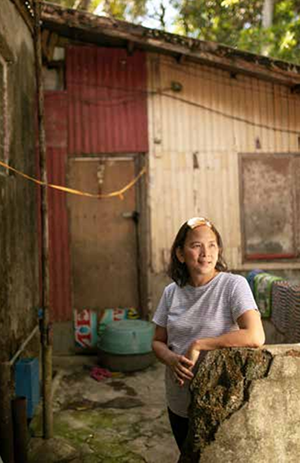
Resureccion Agapito, 52, has lived in SJDM—and experienced its water problems—her whole life.
At San Miguel, we’ve always advocated for responsible water use. We encourage our businesses to use only what is necessary and to continuously seek ways to reduce water consumption. In fact, just recently, we reported significant gains in our efforts to reduce operational water use. By 2025, our target is to cut in half our total operational water use. In 2018, we successfully reduced by 25.3% our water use, equivalent to 8.8 billion cubic meters (m3).
But beyond saving water, we're also conscious of the bigger role we can play in addressing access to water and water scarcity. Our Bulacan Bulk Water Supply Project is a landmark effort that will provide a reliable and clean supply of water to 24 water districts in Bulacan.
This year marks the start of commercial operations of BBWSP. Currently, it serves six water districts through Stage 1 and Stage 2, with the rest to follow once Stage 3 is up and running. Through BBWSP, raw water from the Angat Dam is treated and supplied to water districts at P8.50 per cubic meter, the lowest rate for bulk water in the country.
The facility can produce up to 388 million liters per day (MLD) of water, more than enough to meet future demand. The plant uses state-of-the-art equipment and employs experts to ensure that the quality of water is well above the Philippine National Standard for Drinking Water.
The facility is designed to be resilient; output will be reliable even under poor weather conditions.
Despite its water dilemma, Bulacan holds great potential for growth. The greater aspiration for the Bulacan Bulk Water Supply Project is that it will bring not just clean water to Bulacan, but also a better quality of life for everyone.
Everybody deserves clean water
In the Philippines, more than half of our total population still has no residential piped-in water, and close to 16 million don’t have access to improved water sources.
The lack of clean water has significant implications on a community’s development. For one, economic growth can be stifled if the demand is unserved. And as communities grow, the need for water increases. If there is no reliable source of water, people will look to unsafe water sources. This can have negative effects on their health, and adversely impact the environment.
The most populated province in Central Luzon, Bulacan, has struggled to supply water to its 3.2 million residents. The water districts assigned per town are responsible for supplying water to each house, but due to their limited capacity, supply often falls short. The situation varies per area—some would have water but this would be of poor quality; others would have it, but only at certain times. And then there are those who would have no water at all.
Because of this, residents turn to groundwater, or water sourced from deep wells. Groundwater is an attractive option because for a long time, it was readily available and cheap. The downside to deep wells is is that they are prone to contamination by saltwater, coliform, and other harmful substances.
But a far larger problem caused by deep wells is land subsidence, making communities vulnerable to flooding.
Resureccion Agapito, who has lived in SJDM her entire life, says their water situation has improved over the years, with the installation of water pipes directly to their homes. But steady supply is still a problem.
During the dry season, pressure is low and rationing is a common occurence. In the rainy season, the local water district takes longer to treat the water as their raw water becomes heavily silted because of soil erosion and sedimentation.
With the beginning of commercial operations of the Bulacan Bulk Water Supply Project, a steady supply of water will no longer be a pipe dream for Agapito and all it will serve.
The family of Lola Hening Gumafelix, 80, is among those eagerly waiting for a steady supply of water. Today, they still rely on the deep well or poso in their backyard for their daily water needs. Before they had their own deep well, her husband had to fetch water from a shared deep well, or draw water from a nearby creek. Nowadays, residents have taken to building their own system so they can have water. Their drinking water comes from a nearby water refilling station and costs them about P25 per gallon.
Things are looking up with the BBWSP. It's a state-of-the-art facility that has enough capacity to meet even future demands for water in the province.
Despite its water dilemma, Bulacan holds great potential for growth. The greater aspiration for the Bulacan Bulk Water Supply Project is that it will bring not just clean water to Bulacan, but also a better quality of life for everyone.
The New Manila International Airport will be our biggest contribution to the Philippine economy. It will usher a new era of growth for the country.
Between the time this report is written and released to stockholders in early June 2019, the Swiss Challenge period for San Miguel Corporation’s proposed New Manila International Airport (NMIA) in Bulacan would be well underway. If no other company puts forth a comparable offer to build one of the most ambitious infrastructure projects in our country’s history, Filipinos could be enjoying more than just a world-class airport some five years after its groundbreaking.
Filipino travelers will have a greater sense of pride when they fly in from other countries. Facilities will be more than adequate, service levels will be consistently high, there will be zero delays caused by air, runway or taxiway congestion.
Because in truth, the NMIA project, for San Miguel, goes beyond just building a structure.
For sure, the sheer scale of the development can’t be downplayed. With an investment totaling some US$14 billion, NMIA will feature four parallel runways, with more than four times the constrained capacity of the existing intersecting runways of NAIA.
There is ample space to construct a high-capacity runway system and airport complex that will ensure the efficient handling of 100 million passengers per year. The entire development, consisting of worldclass terminals and airport facilities, will be built on a 2,500-hectare property in Bulakan, Bulacan, adjacent to the Manila Bay.
Dubbed an “aerotropolis”, it will have its own seaport, industrial, residential, commercial, and institutional zones. Also included in its design is the development of a new government center making vital government services more accessible to fast-growing areas in Central Luzon.
All this will be accessible from Metro Manila in less than thirty minutes, via interconnected expressways and rail—including a shoreline expressway that will traverse Manila Bay and head straight to NMIA.
NMIA will mean many things for the Philippines. It will be a showcase of what Filipinos can do. It is a long overdue and much-needed solution to problems rooted in our aging and inefficient airports—where flight delays and congestion are the norm.
Filipino travelers will have a greater sense of pride when they fly in from other countries. Facilities will be more than adequate, service levels will be consistently high, there will be zero delays caused by air, runway or taxiway congestion.
Airport congestion is a serious problem that both airlines and passengers have to contend with. In the present NAIA, annual losses of airlines brought about by air traffic congestion are estimated to reach more than P10 billion per year. This will continue to grow if no new airport capacities are built.
On the other hand, productivity losses of passengers are estimated to amount to more than P15 billion per year.
Moving the country's main gateway out of Metro Manila will also help alleviate the nightmarish traffic situation on major and secondary roads in cities around the present airport—Paranaque, Pasay, Las Piñas, Manila, Makati—and beyond.
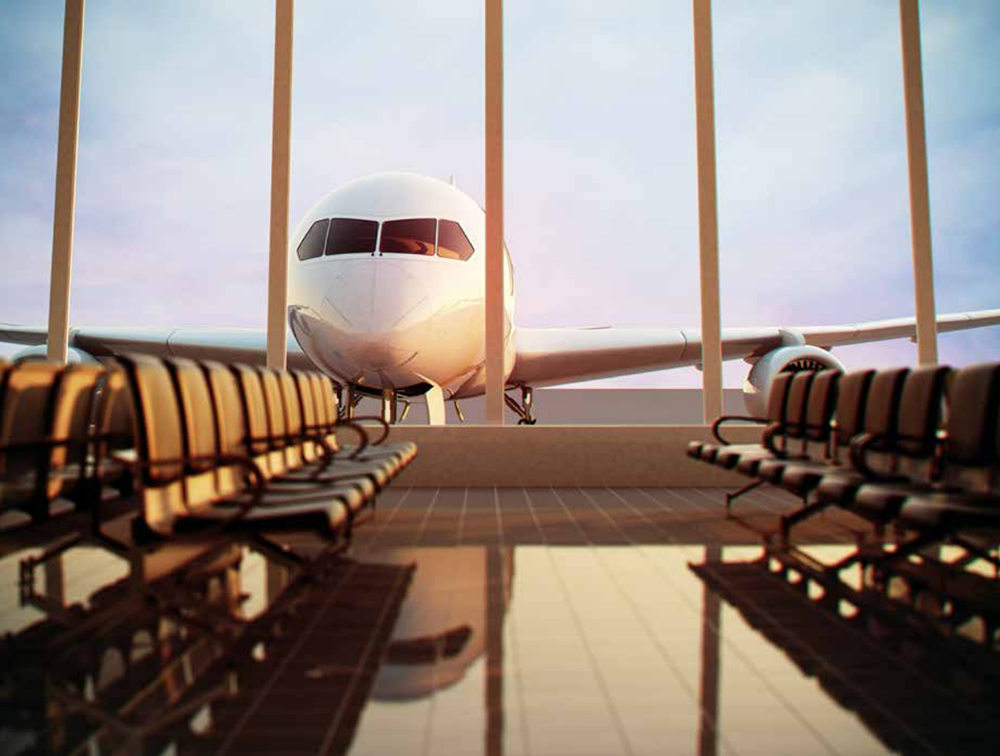
The NMIA will signal to the world that the Philippines is finally ready to take its place among the ranks of Asia’s rising economies. It will boost tourism, raise our profile as an investment destination, and increase the competitiveness of our industries—including manufacturing and exports. It can even help bring about the development of new, technology-based industries.
Overall, it is seen to add an estimated P400 billion to the country’s Gross Domestic Product (GDP) and generate at least one million jobs.
In 2018, the Philippines recorded some 7.1 million tourist arrivals. We are well behind our ASEAN neighbors such as Thailand (38.27 million tourists), Malaysia (33.1 million tourists), Singapore (18.5 million), Indonesia (15.8 million), and Vietnam (15.5 million).
If the Philippines can reach 20 million tourists, then that will equate to an estimated 40 million new tourism industry-related jobs.
The government’s Build Build Build program promises to fix our country’s infrastructure gaps. Boracay’s successful rehabilitation has made headlines all over the world, sparking renewed interest in our islands. It also serves as a model for our other tourist destinations.
Once complete, the NMIA is envisioned to be among the best airports in the region: the game-changer the Philippines has needed all this time.
We do business responsibly
Creating platforms for economic growth
US$14 billion TO BE INVESTED IN NEW AIRPORT
SMC's proposed New Manila International Airport (NMIA) will be one of the largest and most ambitious infrastructure projects in the country. It will raise the Philippines' competitiveness as an investment and tourism destination, boost both local and the national economies, and greatly improve air travel for Filipinos. It is seen to help generate some 40 million indirect tourism-related jobs when fully operational.
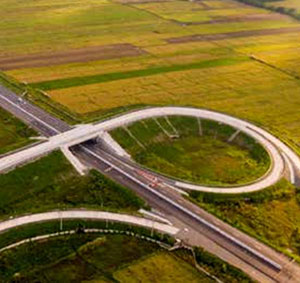
P300+ billion INVESTED ON INFRASTRUCTURE
Since 2008, SMC has invested more than P300 billion on major infrastructure projects that have helped drive Philippine economic growth. To date, the company operates a total of 190 kilometers of toll roads, an airport, and a bulk water supply project. It has proposed to build a new international airport that will address congestion issues and boost economic growth.
212,500 CARS PER DAY TAKEN OFF THE ROADS At four passengers per car
The MRT-7 project will help decongest Metro Manila and transform San Jose del Monte into a major growth center. For Bulacan residents, it will mean better, safer, faster commutes to Quezon City and the rest of the metro. For investors and business locators, it will mean a viable alternative location to do business— which will result to even more job opportunities for locals. With 14 stations and 108 rail cars, it will serve an estimated 850,000 passengers per day.
In early 2019, San Miguel announced an initiative to develop the country's first recycled plastics roads. Partnering with materials science company Dow Chemical, it aims to use hard-to-recycle plastics as an alternative raw material to asphalt for road building. Among the benefits of recycled plastic roads: improved stability and durability of road surface; greater skid resistance, which improves road safety; longer lifespan; lower asphalt costs, and less wastes destined for landfills.
Magnolia Chicken is committed to keeping its products free of antibiotic residue. Magnolia chickens are raised in Climate-Controlled System Broiler Farms to ensure they are comfortable and stress-free. Meanwhile free range chickens are given adequate feeds and ample room to grow. Magnolia poultry products are free of artificial chemicals, antibiotics, hormones, and steroids.
San Miguel Brewery Hong Kong Limited (SMBHK) advocates against drunk driving. It educates consumers through a program called the Forum for Responsible Drinking (FRed). SMBHK conducts university tours and has partnered with an educational theatre company to increase awareness on the effects of under-age drinking.
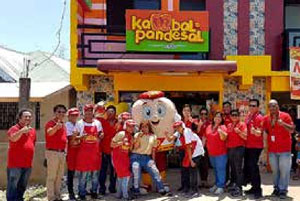
4000+ FRANCHISED OUTLETS & STORES
San Miguel Pure Foods provides livelihood and business opportunities for small entrepreneurs through franchised businesses using its most-trusted brands, such as TJ Hotdogs, Kambal Pandesal, and Monterey. It also offers various distributorships around the country.
During the six-month rehabilitation of Boracay, SMC partnered with the Department of Environment and Natural Resources (DENR) to adopt and restore Wetland 3 in Barangay Balabag, Boracay in Malay, Aklan. In a span of two months, we were able to clear the drainage and sewage system of Wetland 3. The company also collaborated with the Technical Education and Skills Development Authority (TESDA) and the local government of Aklan to conduct a skills training program for 250 residents and displaced workers.

P332M BUSINESS STARTUP PACKAGE For the families of Marawi's fallen heroes
SMC provided business startup packages worth P2 million each to the 166 families of soldiers and policemen killed in active duty during the Marawi conflict. The families were allowed to select franchised businesses from among its established brands: Kambal Pandesal, BMEG Feeds, and TJ Hotdogs. To date, 120 families have already been matched to a business.
Petron’s 140-MW Refinery Solid Fuel-Fired Boiler (RSFFB) generates electrical and steam energy sufficient to sustain the full operations of the Bataan Refinery without tapping into the Luzon grid. The plant also produces surplus energy— approximately 10 MW—which it contributes to the grid. The RSFFB uses a by-product of RMP-2 as feedstock. The power plant is also one of the first in the Philippines to use circulating fluidized bed (CFB) technology which reduces emissions by roughly 95% compared to other coal plants.

SMC Infrastructure regularly holds road safety fora among its stakeholders and implements a program called Project TASK (“Tamang Asal Sa Kalsada”), the only tollroad program in the country that engages various sectors of the community in promoting road safety. Seminars are designed for drivers, transport operators, students, traffic operators, and tollway patrollers, for them to better understand road safety as well as laws and regulations.
B-MEG Fiestahan is a nationwide series of hog-raising seminars for backyard growers. It had 11 runs in 2018 and reached a total of 16,489 growers. The seminars provide practical knowledge on hog-farming so growers can maximize their profits and raise good-quality livestock.
150,000+ bottles RETRIEVED IN ONE BARANGAY
Ginebra San Miguel Inc.'s (GSMI) “Boteful Project” helps close the loop in handling waste through the retrieval and reuse of bottles, with the help of local communities. Initially launched in Aparri as a partnership with Barangay Maura, the program resulted to the retrieval of some 150,000 bottles. In exchange, GSMI provided the barangay with CCTV cameras to help local officials maintain peace and order. GSMI is set to implement the project nationwide.
28,598 DIRECT JOBS
San Miguel directly employs 28,598 regular employees. For every job created within the San Miguel system, many other jobs are created through suppliers, distributors, retailers, and other business partners.
To boost domestic tourism, SMC Infrastructure has partnered with the Department of Tourism (DoT) and local governments to promote historical, cultural, and religious destinations. These efforts have helped transform rural communities into higher-class municipalities and connected once remote provinces in North and South Luzon to the National Capital Region and other urban centers.
Bank of Commerce partnered with World Vision for the Community-Managed Savings and Credit Association (CoMSCA) project, a program designed to create a local pool of capital in Molinete, Laurel, Batangas. As a complementary program, BOC also launched CoMSCA Children, a financial literacy program.

To properly dispose of waste by-products, SMC Global Power’s Limay Power Plant redirects its fly and bottom ash to partners Northern Cement and Petron. The waste by-product is hauled and used as an alternative for silica sand, which serves as bed material for its CFB boilers. Northern Cement uses fly ash as a lightweight aggregate.
500% CLEANER FUEL Compared to Euro 4 standard
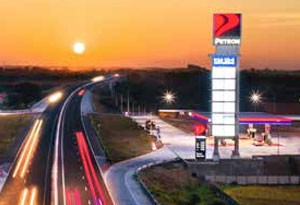
Petron’s Blaze 100 Euro 6 is the first and only premium gasoline with 100 octane in the Philippine market. It is more than 500% cleaner compared to the Philippines’ current Euro 4 standard based on sulfur content. Blaze 100 Euro 6 contains less than 3 ppm (parts per million) sulfur while Euro 4 contains up to 50 ppm. Due to its low sulfur content, it prolongs the life of vehicle emission control devices and catalytic converters, thus allowing vehicles to have much cleaner emissions over its operating lifetime.
SMC Global Power’s LEAP (Local Economy Accelaration & Progress) program helps fund processing facilities that local entrepreneurs can use to develop prototypes and scale their local products. LEAP helps with distribution, access to micro-financing, and skills training. Among LEAP's beneficiaries are farmers, fishermen, and cultural minorities.
The San Miguel Yamamura Packaging Group's Laguna Caps Plant is taking concrete steps towards making better use of their raw materials. Apart from recycling metal caps, LCP has developed PET products using PET regrinds.
We are a good neighbor
Building self-reliant and resilient communities
3 million MEALS PER YEAR
SMC’s first Better World Communities aim to serve at least three million meals a year to the poorest of the poor. San Miguel Food and Beverage, Inc.'s Food Group, together with San Miguel Properties, Inc., are working closely with Rise Against Hunger and AHA! Learning to develop a community center in Tondo, Manila. This center will be a staging ground for various initiatives aimed at providing the less fortunate with knowledge, skills, and capability to lift themselves out of poverty.

Petron’s scholarship programs provide a path out of poverty for deserving students from low-income families. Around 187 Petron scholars are now part of the Petron workforce. The Automotive Care Education (ACE) program, in partnership with Petron’s National Sales Division and TESDA, trains out-of-school youth on automotive servicing. The first batch of 15 graduates now work as mechanics in Petron Car Care Centers.

163 CONTRACTED FARMERS
49,000 hectares
Through its Cassava Assemblers Program (CAP), San Miguel Pure Foods engages some 163 farmers to plant cassava on 49,000 hectares of land, with an annual yield of roughly 148,000 metric tons. The company guarantees offtake that provides them security of income. B-MEG, its feeds business, also works with farmers to provide them raw materials, training, and technology that can increase productivity.
San Miguel Brewery Inc. continues to be active in disaster response and relief efforts. It donated an amphibious vehicle and five rubber boats to the Armed Forces of the Philippines (AFP); a fire truck for the municipality of Sta. Cruz in Davao del Sur, and, in response to the eruption of Mayon Volcano, it sent 250 SMB employee volunteers to repack and distribute relief goods to victims.
San Miguel Foundation spearheads Water, Sanitation and Hygiene (WaSH), a program committed to providing potable water and sanitation facilities to partner communities. SMF partnered with PBSP to deliver water systems to communities in Quezon and Sarangani. To date, SMF has set up WaSH facilities in Cavite, Davao del Sur, Davao Occidental, and Marawi.
San Miguel Pure Foods’ flagship program “Handog Kalusugan”, provided one meal per day for 120 days to children in day care centers and public elementary schools in seven areas in Luzon. Since 2012, a total of 16,700 children benefited from this program.
Through “Malusog na Katawan, Matalas na Isipan”, a supplemental feeding program, 150 children aged four to eight were given one full meal a day for five days a week for a period of four to six months.
124,000 PATIENTS SERVED
SMC maintains a network of community clinics located in Valenzuela, Pampanga, Cebu, Bacolod, Davao del Sur, Batangas, Tarlac, and Bukidnon. These clinics provide free consultation, diagnostic services, and medicines to indigent patients. A number of these clinics are fully-equipped with X-Ray, ECG, and ultrasound machines. Over 14,000 patients have benefited from the clinics in 2018.
San Miguel Foundation has worked with Gawad Kalinga and Habitat for Humanity to build houses for underprivileged families. It also works with the Philippine chapter of the US-based food bank agency Rise Against Hunger to launch a food rescue and feeding program. SMF has also partnered with the School for Experiential and Entrepreneurial Development Philippines (SEED PHILS) to implement an entrepreneurship program for young people.
P254 million FOR CLASSROOMS AND LIBRARIES
To help public school students in its host communities, the company spent P254 million to build 254 classrooms and libraries in various locations nationwide.
Over the years, SMC has given scholarships to 3,883 students in college and in technical vocational courses.
The San Miguel Foundation has pioneered “Happy si Mommy, Malusog si Baby,” a maternal health program where mothers receive health and nutrition support for 1,000 days from conception to the child’s second year. The first 1,000 days program was rolled out in communities in Pampanga, Bacolod, Davao del Sur, and Davao Occidental.

1,000 PETRON STATIONS WITH POLICE OUTPOSTS
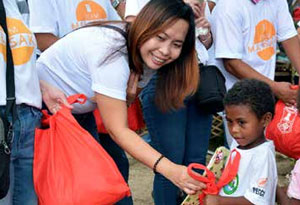
Petron's road safety programs support efforts to halve the number of global deaths and injuries from road traffic accidents by 2020. Petron’s 33- year old Lakbay Alalay is the Philippines’ longest-running road assistance project. Petron's Lakbay Ligtas program, a partnership with the Philippine National Police, turns some 1,000 Petron service stations throughout the country into strategic safety points with police outposts.
“Helping People Help People” is a new volunteer program that allows SMC employees to donate a portion of their salaries to send underprivileged youth either to universities or TESDA. To date, the project has raised over P1 million.
500 HOSPITAL BEDS Plus other medical donations in conflict areas
The company allocated P21 million for the construction of a transient facility for AFP personnel and donated an additional P2 million for the renovation of a hospital trauma center in Jolo, Sulu. The company also donated P41 million worth of hospital equipment to Camp Teodulfo Bautista in Jolo, Sulu, and 500 hospital beds to the V. Luna hospital.
San Miguel Food and Beverage, Inc.'s (SMFB) “Handog Komunidad” is a program that helps communities address various social issues. Through its partnership with International Justice Mission (IJM) Philippines—an NGO that advocates against online sexual exploitation of children—the company helped in the rehabilitation of 10 rescued children, who were also given scholarships. They are under the care of shelter Lost Coin Philippines.
San Miguel allocated P5 million for a literacy program for five schools in Malita, Davao Occidental. The project includes the donation of reading centers and speech and computer laboratories to the schools. To date, around 5,000 learners, 50 teachers, and 50 parents have benefited from the project.
Ginebra San Miguel Inc. (GSMI) has partnered with TESDA to provide entrepreneurship training for deserving students. Graduates are given a mobile bar business package to get them started. For almost two decades now, GSMI-Distileria Bago, Inc. has supported two day care centers in Bago City.
2,000 TEAM MALASAKIT EMPLOYEE VOLUNTEERS
In support of the Department of Education’s Adopt-a-School project, over 2,000 employee volunteers helped rehabilitate a total of 69 schools nationwide. The company also donated 110 laptops to adopted schools.
To help government in its anti-smuggling and anti-crime efforts, SMC donated P126 million worth of Rapiscan mobile X-Ray units to the Bureau of Customs (BoC). It also donated 50 BMW motorcycles to the Philippine National Police.
60,436 FAMILIES ASSISTED AFFECTED BY CALAMITIES AND ARMED CONFLICT, HELPED
Since 2016, the SMF has provided assistance to some 60,436 families affected by calamities and armed conflict. Total donations have amounted to P349,173,500.

P2.1 billion for 7,936 HOUSES
To date, SMC has built a total of 7,936 new houses for calamity victims and underprivileged families. Through the San Miguel Foundation, the company has built communities in Leyte, Misamis Oriental, Iligan, Cagayan de Oro, Bohol, Davao, and Laguna. SMC has spent some P2.1 billion for these projects, considered the largest corporate social responsibility grant in the Philippines.
We are stewards for future generations
Protecting natural resources is part of the way we do business
8.84 billion liters OF WATER SAVED
Two years after launching our group-wide water initiative, SMC has already posted an aggregate 25.3% reduction in water consumption. Thus far, San Miguel has saved 8.84 billion liters of water under its “Water For All” program, which aims to reduce the company’s water footprint by 50% by year 2025. In 2018, San Miguel and its subsidiaries beat by two years its 2020 interim target of 20% reduction.
32 million plastic bottles ELIMINATED
By exiting the bottled water business, the company has effectively stopped an estimated 32 million plastic bottles a year from being produced and ending up in landfills or bodies of water.
In 2018, SMC announced that it was banning single-use plastics in its facilities, a follow-up effort to its discontinuation of its bottled water business.
SMC Global Power’s Biochar Community Enterprise Development Project aims to preserve and protect the environment and help mitigate climate change through carbon sequestration. Indigenous peoples groups such as the Aeta Tribes in Palauig (ATIP) and Pinagrealan/Lauis Upland Farmers Inc. (PILUFA) and members of the Panaliwan Livelihood Center IP, underwent Biochar Production and By-Products and Derivatives Training. Participants gained a working knowledge of how to produce and activate biochar and harvest liquid smoke.
1.5 million people NOW HAVE ACCESS TO CLEAN WATER
The Bulacan Bulk Water Supply Project (BBWSP) currently services six water districts in Bulacan, with an estimated population of 1.5 million people. It will provide stable and potable water supply to a total of 24 water districts in the province. Bulacan, the third most populated province in the Philippines, has long-struggled with access to water.
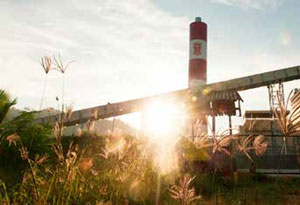
SMC Global Power Holdings Corp operates two greenfield power facilities: the Limay, Bataan plant and the Malita, Davao plant. Both utilize Circulating Fluidized Bed (CFB) clean coal technology that drastically reduces emission levels. These power plants undergo daily emission testing. Average results show that nitrogen dioxide, sulfur dioxide, carbon monoxide, and particulate matter emissions are consistently below Department of Environment and Natural Resources (DENR) and World Bank limits.
GSMI's Distileria Bago, Inc. received certification from the Fertilizer and Pesticide Authority for their treated wastewater which qualifies as liquid fertilizer. Now a spinoff business, the treated wastewater is sold under the name “Farm booster” for use in sugar cane farming.
Together with Reef Check Philippines, a non-profit organization dedicated to marine conservation, the Food Group held Handog Kalikasan: Coral Care, an educational workshop on the importance of corals and how to protect marine life. This is in preparation for a holistic coral propagation project in Mabini, Batangas.
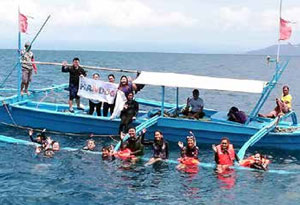
To treat wastewater, SMB breweries in Mandaue, Davao, and Polo, as well as GSMI’s Distileria Bago, Inc. (DBI) use a process that effectively reduces organic pollutants by as much as 65%. After this, wastewater goes through another process to further clean it to meet DENR discharge standards.
The process also generates biogas (methane) which is used to fuel boilers that generate steam, resulting to fuel savings.
At Mandaue Brewery and Polo Brewery, part of the treated wastewater is used as gardening and cleaning water.
15,349,827 cubic meters OF WATER SAVED
To reduce freshwater and groundwater extraction and minimize the environmental impact of its refinery in Limay, Bataan, Petron invested in a state-of-the art desalination facility which processes seawater to cool the power plant and provide treated water for RMP‑2. Together with rainwater harvesting at most of its depots, Petron was able to cut surface water use by 15,349,827 cubic meters in 2018, a 26% improvement over the previous year.
Petron actively participates in the National Greening Program. As of 2016, volunteers from the Petron Bataan Refinery and Petron Operations collectively planted a total of 45,785 mangrove and tree seedlings in various locations throughout the country. The company also sponsored students under the Professional Masters in Tropical Marine Ecosystems Management (PM-TMEM) program of the University of the Philippines Marine Science Institute (UP MSI). Petron also works with the Bantay Pawikan Organization and the Pawikan Conservation Center to raise awareness on the protection of marine turtles which nest in the town of Morong, Bataan.

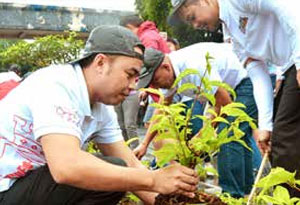
1 million TREES PLANTED AND GROWN
Now on its ninth year, San Miguel Brewery Inc.’s Trees Brew Life program has planted and grown nearly one million assorted fruit-bearing, forest, and mangrove tree species in Pampanga, Laguna, Negros, Cebu, and Davao del Sur, as well as in Quezon City and Makati. SMB also maintains a tree nursery in San Fernando, Pampanga. The program supports the Department of Environment and Natural Resources’ (DENR) goal to rehabilitate and reforest unproductive, denuded, and degraded areas.
SMB maintains programs to protect and preserve vital waterways. An average of 10,000 cubic meters of garbage is collected annually from the Tullahan River. In Mandaue, SMB supports the Tipolo Creek clean-up program of DENR. The company also supports Bacolod's Adopt-an-Estero program by helping clean up the Cabacauan Creek. Breweries in Pampanga and Davao maintain waterways near their facilities. SMB is also involved in estero cleanup projects initiated by the city governments of Makati and Las Piñas, and of the Metro Manila Development Authority.
Since 2000, Petron has been a prime mover of the Bataan Integrated Coastal Management (ICM) Program, together with the UNDP Partnerships in Environmental Management for the Seas of East Asia (PEMSEA) and the provincial government of Bataan. This comprehensive and long-term initiative helps manage the coastal and marine resources of the province and by extension, Manila Bay, by promoting sustainable development throughout Bataan.
7 million NEW TREES TO BE PLANTED
SMC Global Power's “Ridge to Reef” conservation program aims to plant seven million trees on 4,000 hectares of land over seven years, starting this year.
1:1 Success Ratio FOR RECYCLING PLASTIC PRODUCTS
The San Miguel Yamamura Packaging Group runs a cullet collection program that has proven efficient in recovering glass bottles used to create brand new bottles. SMYPG partners with LGUs in the provinces and sets up cullet collection hubs to further increase recovery. Meanwhile, its Logistics Services unit's internal pallet crushing project recovers damaged pallets and makes them into new plastic products at the Manila Plastics Plant. The plant recovers, crushes, and produces brand new products with a success ratio of 1:1.
P1 billion TO CLEAN UP TULLAHAN RIVER
San Miguel and the DENR formalized a joint commitment to undertake an extensive cleanup of the Tullahan river system—a crucial step to rehabilitating the Manila Bay. The P1 billion project involves dredging the 59.24-kilometer tributary that starts from the La Mesa Reservoir and spans the cities of Valenzuela and Malabon, and drains into the Manila Bay in Navotas City.
SMC Infrastructure has long been rehabilitating creeks that run perpendicular to its expressways through its Adopt-an-Estero program. In partnership with the DENR, Skyway O&M Corporation has worked to improve four waterways: Maricaban Creek in Pasay and Pasong Diablo, Pasong Capre, and Pasong Pari creeks in Muntinlupa. In addition, the NAIA Expressway team dredged and cleaned up the Parañaque River. It also took care of relocating informal settlers along the river. Skyway Stage 3 construction also includes cleaning up the San Juan River.
63,000 tons OF CARBON TO BE CAPTURED
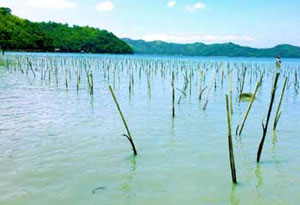
Since 2000, Petron volunteers have planted over one million mangrove and tree seedlings all over the country. Its “Puno ng Buhay” program adopts areas for reforestation to protect critical watersheds and minimize carbon footprint. Petron adopted a total of 85 hectares to plant mangroves and bamboo. Thus far, it has captured some 387 tons of carbon from its reforestation sites in Leyte and Roxas. In the next three years, the program will see Petron plant 200,000 new trees and mangroves nationwide. This will result to at least 63,000 tons of carbon captured annually.



